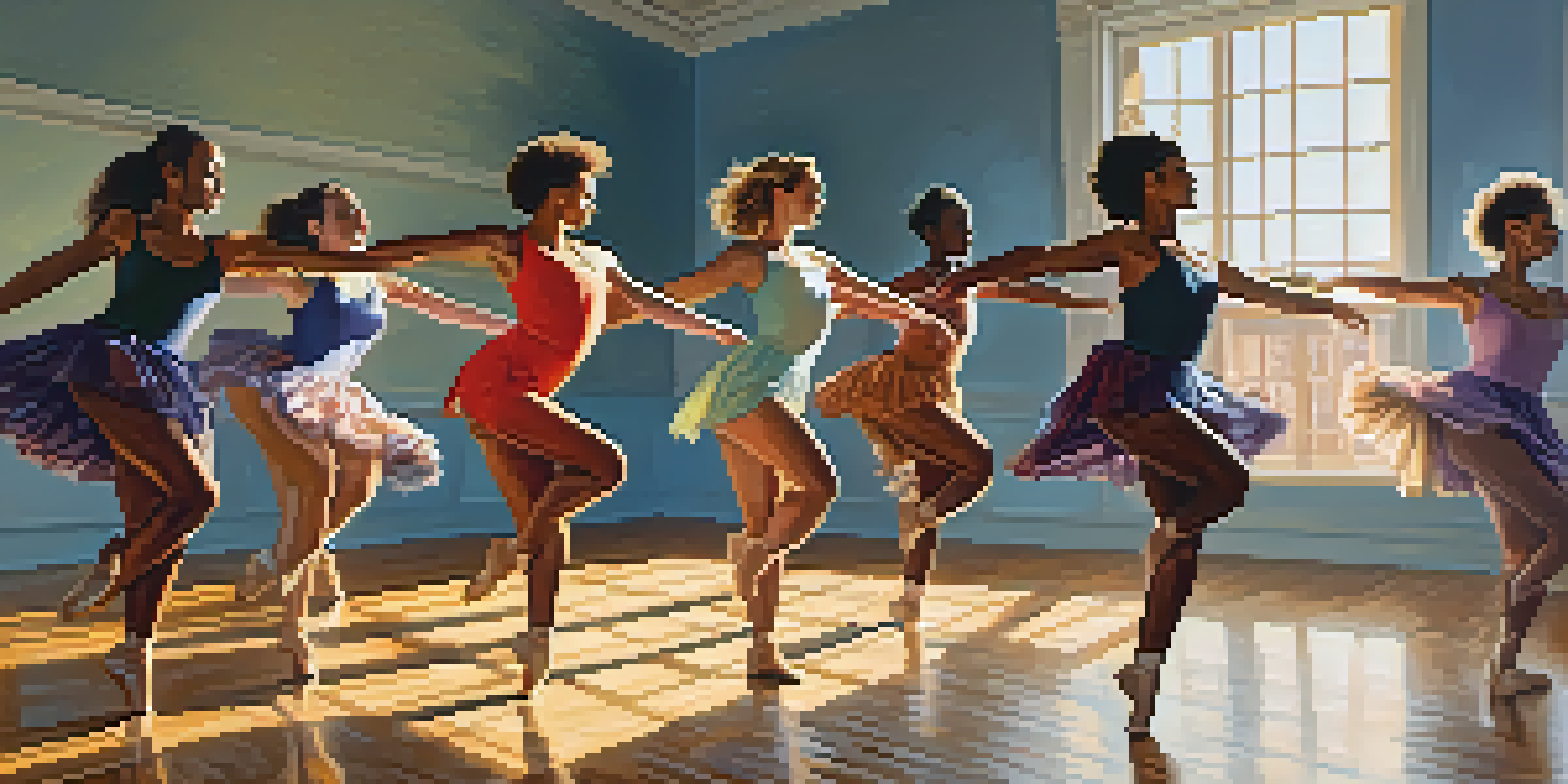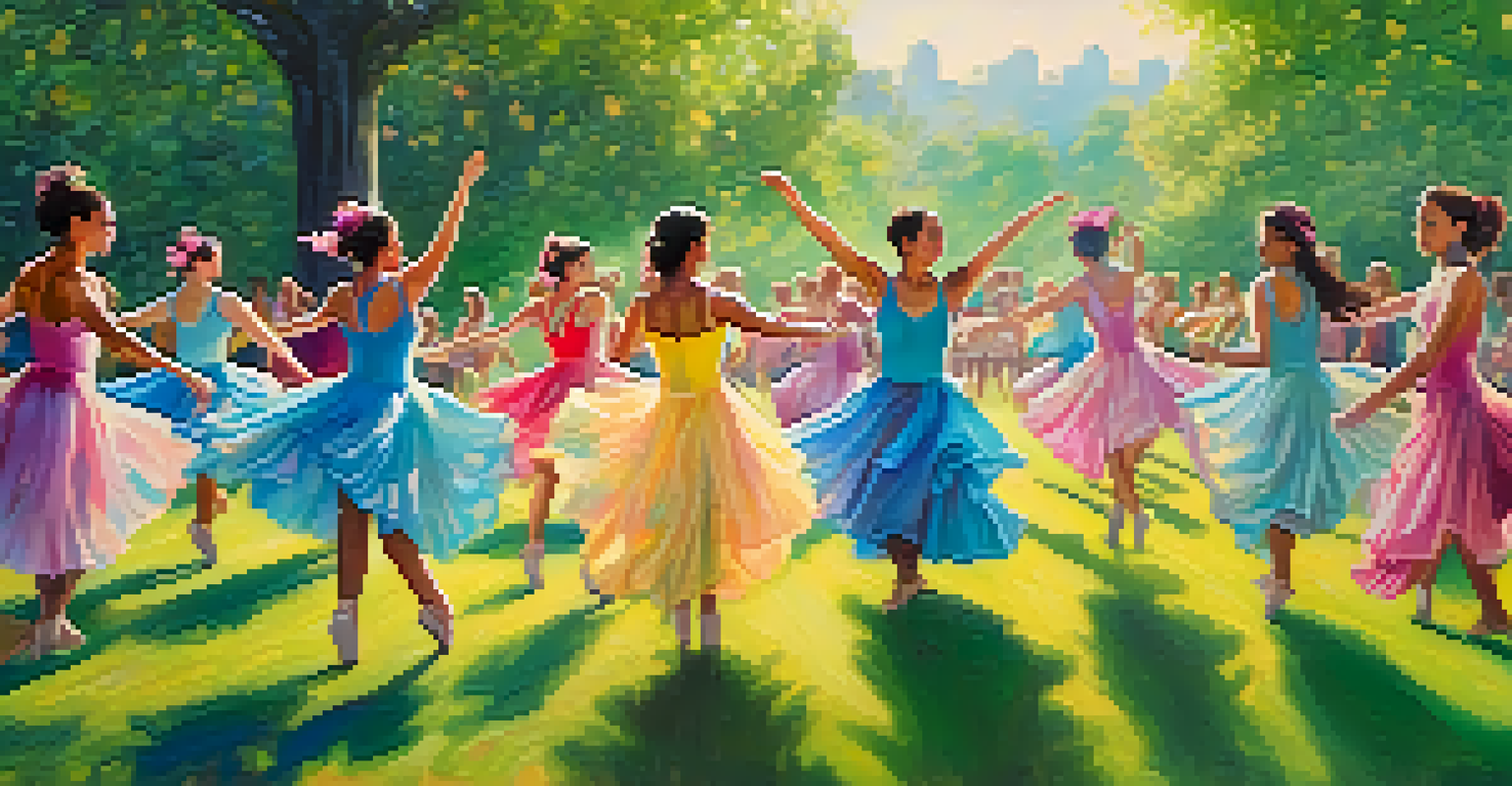The Impact of Dance on Body Image and Self-Perception

Dance as a Form of Self-Expression and Freedom
Dance is often seen as a powerful form of self-expression, allowing individuals to communicate emotions and stories without words. This form of expression can significantly impact how dancers perceive their bodies, as they learn to celebrate movement and individuality. For many, the joy of dancing helps to cultivate a deeper appreciation for their own physical form, fostering a sense of freedom and confidence.
Dance is the hidden language of the soul.
When people engage in dance, they often become more attuned to their bodies, recognizing their unique strengths and capabilities. This awareness can lead to a positive shift in body image, as individuals start to focus on what their bodies can do rather than how they look. As they express themselves through movement, they may find that the joy of dance outweighs societal pressures about appearance.
Moreover, participating in dance communities can create a supportive environment where body positivity thrives. Surrounding oneself with others who share similar passions can help reinforce a positive self-image and encourage acceptance of diverse body types. As dancers celebrate each other’s unique styles and forms, they often embrace their own bodies more fully.
The Role of Dance in Building Confidence
One of the most significant benefits of dance is its ability to boost confidence. As individuals learn new movements and master choreography, they often experience a sense of accomplishment that translates into higher self-esteem. This newfound confidence can spill over into other areas of life, affecting how individuals view themselves in various situations.

For many dancers, performing in front of an audience can be a transformative experience. The act of sharing their artistry with others allows them to embrace vulnerability while also receiving positive feedback, which reinforces their self-worth. Over time, these experiences can reshape how they perceive their bodies and their overall self-image.
Dance Empowers Self-Expression
Through movement, individuals can communicate emotions and celebrate their unique bodies, fostering confidence and body positivity.
Additionally, dance often promotes a culture of support and encouragement, where participants cheer each other on. This camaraderie can lead to a stronger sense of belonging and acceptance, helping dancers feel more comfortable in their skin. As they forge connections with others, they may find that their confidence continues to grow both inside and outside the dance studio.
Challenging Beauty Standards through Dance
Dance has the power to challenge conventional beauty standards by showcasing a variety of body types and styles. Many dance genres celebrate diversity, encouraging dancers to embrace their unique physiques rather than conforming to a singular ideal. This inclusivity can significantly impact how individuals perceive their own bodies and those of others.
The body says what words cannot.
By promoting diverse representations in dance, artists and choreographers can help shift societal perceptions of beauty. As audiences witness a wider range of body types on stage or in videos, they may begin to question the narrow definitions of attractiveness that dominate mainstream media. This shift can contribute to broader discussions about body image and self-acceptance.
Furthermore, dance communities that prioritize inclusivity often empower individuals to appreciate their bodies for their capabilities rather than their appearance. This focus on movement and expression allows dancers to redefine their relationship with their bodies, leading to healthier self-perceptions that celebrate uniqueness.
The Connection Between Dance and Mental Health
Engaging in dance has been shown to have positive effects on mental health, which can indirectly improve body image and self-perception. The physical activity involved in dancing releases endorphins, often referred to as 'feel-good' hormones, that can alleviate feelings of anxiety and depression. As individuals experience these mental health benefits, they may also become more forgiving and accepting of their bodies.
Moreover, dance can serve as a powerful outlet for stress relief and emotional release. When dancers immerse themselves in movement, they often find a therapeutic space to process their feelings. This holistic approach to well-being can lead to a more positive self-image as individuals learn to embrace their emotions and physicality.
Boosting Confidence Through Dance
Mastering dance skills and performing in supportive environments can significantly enhance self-esteem and reshape body image.
Additionally, dance classes or workshops can foster a sense of community and belonging, which is essential for mental health. By connecting with others who share similar passions, dancers can build supportive relationships that contribute to improved self-esteem. These connections can also help individuals navigate their body image struggles in a healthier way.
The Influence of Social Media on Dance and Body Image
In today's digital age, social media has become a prominent platform for showcasing dance and body image. While it can offer inspiration and community, it can also perpetuate unrealistic beauty standards. Dancers may feel pressured to conform to these ideals, affecting their self-perception and overall relationship with their bodies.
However, social media also provides opportunities for body positivity and diverse representations in dance. Many influencers and dancers use their platforms to celebrate uniqueness and promote messages of self-acceptance. By sharing their own journeys and experiences, they can inspire others to embrace their bodies and find confidence in their movements.
Navigating social media requires a balanced approach, where individuals can appreciate the artistry of dance while remaining mindful of its impact on body image. By curating a positive online environment and engaging with uplifting content, dancers can harness the power of social media to enhance their self-perception rather than diminish it.
Dance Education and Body Image Awareness
Incorporating body image education into dance programs can play a vital role in shaping positive self-perception. By discussing topics such as media literacy and the importance of self-acceptance, educators can help students develop a healthier relationship with their bodies. This awareness can be instrumental in creating a more supportive dance community.
Dance education can also emphasize the joy of movement over appearance, encouraging students to focus on the experience rather than how they look. By prioritizing creativity and expression, instructors can help foster an environment that celebrates individuality. This shift in focus can lead to improved self-esteem and body image among dancers.
Challenging Beauty Norms in Dance
Dance promotes inclusivity, allowing diverse body types to be celebrated and encouraging individuals to appreciate their capabilities over appearance.
Furthermore, workshops and discussions on body positivity can empower dancers to share their experiences and struggles. Opening up conversations about body image can help normalize these discussions and create a sense of solidarity among dancers. Ultimately, education can serve as a powerful tool for cultivating a positive self-image within the dance community.
Conclusion: Embracing the Dance Journey for Self-Acceptance
Dance offers a unique journey of self-discovery, enabling individuals to embrace their bodies and enhance their self-perception. By engaging in movement, dancers can celebrate their individuality while challenging societal standards of beauty. This journey not only fosters a love for dance but also cultivates a healthier relationship with their bodies.
As dancers navigate their experiences, the positive effects of dance on body image and self-acceptance become increasingly evident. Through community support, education, and self-expression, the dance world continues to inspire individuals to find confidence in their unique forms. By embracing the dance journey, people can redefine their self-worth and celebrate their bodies.

Ultimately, the impact of dance extends far beyond the studio or stage. It serves as a powerful reminder that our bodies are worthy of love and appreciation, just as they are. As individuals learn to embrace their dance journeys, they can unlock a deeper sense of self-acceptance, paving the way for a more positive body image.